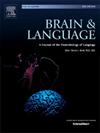Mapping the basal temporal language network: a SEEG functional connectivity study
IF 2.3
2区 心理学
Q1 AUDIOLOGY & SPEECH-LANGUAGE PATHOLOGY
引用次数: 0
Abstract
The Basal Temporal Language Area (BTLA) is recognized in epilepsy surgery setting when cortical electrical stimulation (CES) of the ventral temporal cortex (VTC) trigger anomia or paraphasia during naming tasks. Despite acknowledging a ventral language stream, current cognitive language models fail to properly integrate this entity. In this SEEG study we used cortico-cortical evoked potentials in nine epileptic patients to assess and compare the effective connectivity of 73 sites in the left VTC of which 26 were deemed eloquent for naming after CES (BTLA). Eloquent sites connectivity supports the existence of a basal temporal language network (BTLN) structured around posterior projectors while the fusiform gyrus behaved as an integrator. BTLN was strongly connected to the amygdala and hippocampus unlike the non-eloquent sites, except for the anterior fusiform gyrus (FG). These observations support the FG as a multimodal functional hub and add to our understanding of ventral temporal language processing.
绘制基底颞叶语言网络图:SEEG 功能连接研究。
当对腹侧颞叶皮层(VTC)的皮层电刺激(CES)在命名任务中引发失认症或副失认症时,癫痫手术就会识别出颞叶基底语言区(BTLA)。尽管腹侧语言流得到了承认,但目前的认知语言模型未能正确整合这一实体。在这项 SEEG 研究中,我们使用九名癫痫患者的皮质皮层诱发电位来评估和比较左侧 VTC 73 个位点的有效连接性,其中 26 个位点在 CES(BTLA)后被认为对命名有影响。有效连接点支持围绕后投射器结构的基底颞叶语言网络(BTLN)的存在,而纺锤形回则充当整合器。基底颞叶语言网络与杏仁核和海马的连接性很强,这与非活跃点不同,但纺锤形前回(FG)除外。这些观察结果支持FG是一个多模式功能枢纽,并加深了我们对腹侧颞叶语言加工的理解。
本文章由计算机程序翻译,如有差异,请以英文原文为准。
求助全文
约1分钟内获得全文
求助全文
来源期刊

Brain and Language
医学-神经科学
CiteScore
4.50
自引率
8.00%
发文量
82
审稿时长
20.5 weeks
期刊介绍:
An interdisciplinary journal, Brain and Language publishes articles that elucidate the complex relationships among language, brain, and behavior. The journal covers the large variety of modern techniques in cognitive neuroscience, including functional and structural brain imaging, electrophysiology, cellular and molecular neurobiology, genetics, lesion-based approaches, and computational modeling. All articles must relate to human language and be relevant to the understanding of its neurobiological and neurocognitive bases. Published articles in the journal are expected to have significant theoretical novelty and/or practical implications, and use perspectives and methods from psychology, linguistics, and neuroscience along with brain data and brain measures.
 求助内容:
求助内容: 应助结果提醒方式:
应助结果提醒方式:


